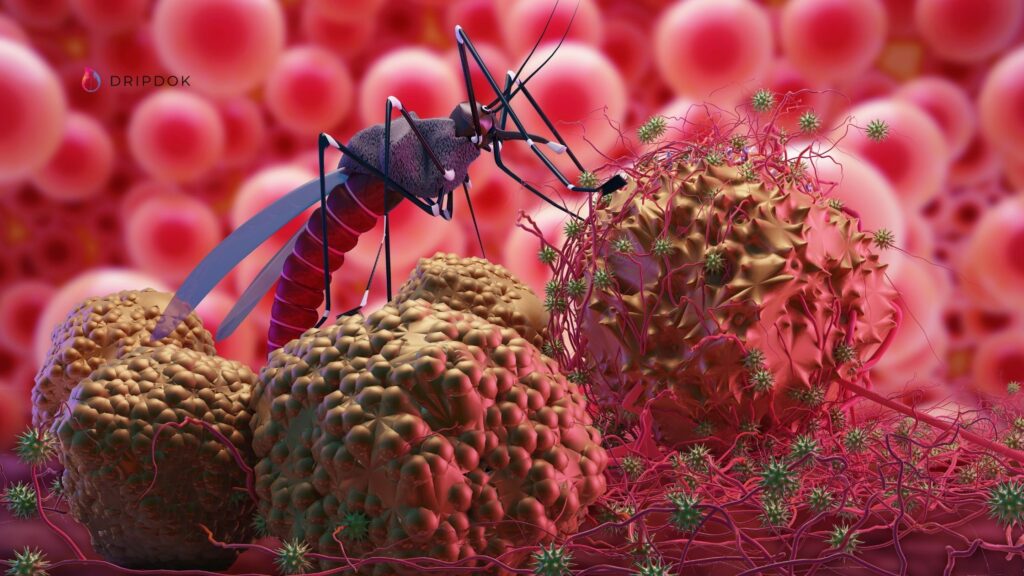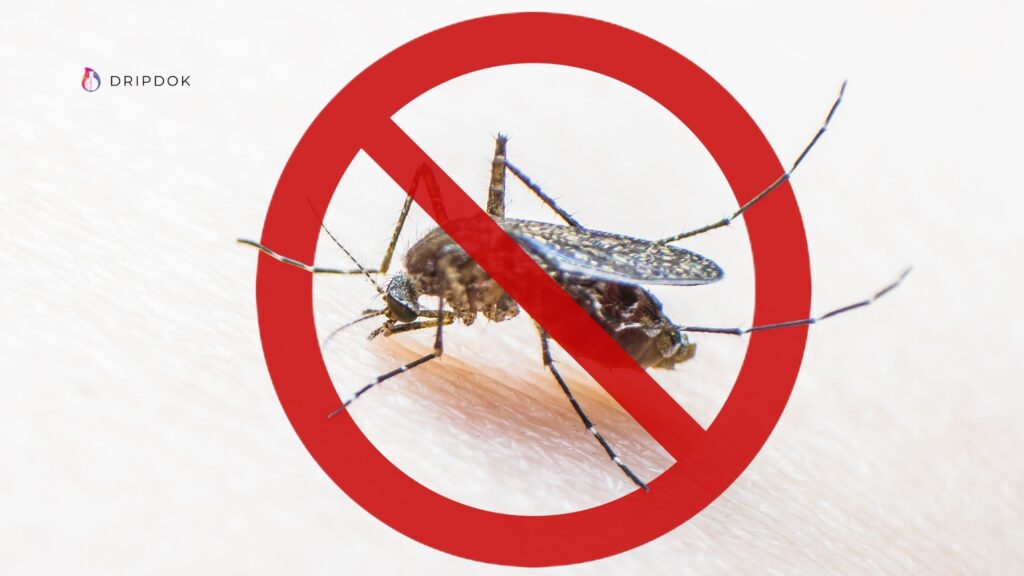
Bali, with its enchanting landscapes and vibrant culture, has long been a magnet for travelers seeking an idyllic escape. However, amidst the beauty lies a silent threat, malaria in Bali. As this mosquito-borne disease continues to affect both locals and visitors, Dripdok emerges as a beacon of hope, offering revolutionary solutions to combat and cure malaria in Bali. In this extensive guide, we will delve into the complexities malaria in Bali, explore the historical context of malaria in Bali and ultimately unveil the transformative power of Dripdok’s Methylene Blue and Thymosin Alpha One in the pursuit of a free malaria in Bali.
Also Read: Dengue Fever In Bali: A Great Way To Protect Your Health
Understanding the Pervasive Threat: Unveiling the Dynamics of Malaria in Bali
Bali, with its captivating tropical climate, lush greenery, and abundant standing water bodies, sets the stage for the flourishing of Anopheles mosquitoes—the notorious carriers of the insidious Plasmodium parasite responsible for malaria in Bali. The intricate interplay of these environmental factors has given rise to a year-round prevalence of malaria in Bali, intensifying the health concerns faced by both the local population and the influx of tourists.
Unraveling the Complex Dynamics:
This omnipresent threat calls for a comprehensive exploration and a nuanced approach to effectively address the multifaceted challenges associated with the disease. It necessitates deciphering the intricate dance between the environment, mosquitoes, and the relentless Plasmodium parasite. Join us as we embark on a journey to unravel the layers of Bali’s unique ecosystem, aiming to comprehend the nuanced factors contributing to the sustained presence of malaria in Bali.
In our exploration, we’ll delve into the following key aspects:
- Environmental Factors: Bali’s enchanting environment, characterized by its tropical climate and lush green landscapes, creates an ideal breeding ground for mosquitoes. Understanding how these factors influence the prevalence of malaria is crucial for developing targeted preventive measures.
- Mosquito Behavior: Anopheles mosquitoes, the primary vectors for the Plasmodium parasite, exhibit specific behaviors that contribute to the transmission of malaria. Examining their habits and tendencies provides insights into effective mosquito control strategies.
- Parasitic Lifecycle: Delving into the lifecycle of the Plasmodium parasite is essential for devising interventions that disrupt its development and transmission. Unraveling the complexities of this microscopic adversary is key to formulating impactful preventive and treatment measures.
Symptoms of Malaria:
A mosquito-borne infectious disease caused by the Plasmodium parasite, continues to be a significant global health concern. Recognizing the symptoms is paramount for early diagnosis and timely intervention. The hallmark of this disease is its cyclic nature, presenting with recurring episodes of high fever, chills, and sweating. Beyond fever, malaria manifests through a range of symptoms, each contributing to the overall debilitation of the affected individual. In this exploration, we delve into the multifaceted symptoms of malaria, shedding light on the intricacies of this infectious ailment and the importance of prompt medical attention.
Fever:
The fever is not a constant elevation but rather presents in cyclic patterns, corresponding with the life cycle of the malaria parasite. These febrile episodes can be debilitating, often causing a spike in body temperature, leading to an intense feeling of heat followed by profuse sweating. The cyclical nature of the fever is a characteristic feature that distinguishes malaria from other illnesses.
Headache and Body Aches:
The headache experienced during a malaria infection can be severe, throbbing, and persistent. This, coupled with general body aches and muscle pain, contributes to a sense of overall malaise. The pain can be localized or widespread, further affecting the daily activities and well-being of the individual.
Nausea and Vomiting:
Malaria-induced nausea and vomiting are not only uncomfortable but can also lead to dehydration, exacerbating the weakness and fatigue already caused by the infection. The persistent feeling of queasiness can affect the appetite, potentially resulting in weight loss.
Joint Pain:
Joint pain, another symptom of malaria, can be particularly distressing. The inflammation and discomfort in the joints add an extra layer of challenge for individuals dealing with this infectious disease. Mobility can be impaired, and the joint pain may linger even after other symptoms subside.
Anemia:
Malaria’s impact on red blood cells often leads to anemia, a condition characterized by a reduced number of healthy red blood cells. Anemic individuals may experience paleness, fatigue, and shortness of breath, highlighting the systemic nature of the infection.
Jaundice:
Severe cases of malaria can affect the liver, resulting in jaundice. The yellowing of the skin and eyes is a consequence of the accumulation of bilirubin, a yellow pigment produced during the normal breakdown of red blood cells. Jaundice is a concerning sign and warrants immediate medical attention.
Sweating and Shivering:
The alternating cycles of sweating and shivering during a malaria episode are not only physically taxing but also mentally draining. The abrupt changes in body temperature contribute to the overall feeling of discomfort and debilitation.
Respiratory Distress:
While relatively rare, severe malaria can lead to respiratory distress. In such cases, immediate medical intervention is crucial, as respiratory complications can escalate rapidly and pose a significant threat to life.
Recognizing these diverse symptoms and their nuances is essential for prompt diagnosis and effective treatment. Malaria remains a global health challenge, and understanding its manifestations is a crucial step in combating its impact on individuals and communities.

The Role of IV Drip Therapy: A Revolutionary Approach to Malaria Treatment
In the realm of combating malaria in Bali, Dripdok’s IV drip therapy stands as a pioneering approach, elevating the standard of care to unprecedented levels. This advanced treatment method utilizes intravenous administration to directly deliver essential nutrients, medications, and fluids into the bloodstream, orchestrating a rapid and targeted response to the malaria infection.
Why Choose IV Drip Therapy?
1. Fast-Acting Relief:
Traditional treatments for malaria in Bali often involve oral medications, which must navigate the digestive system before taking effect. In contrast, IV drip therapy provides a shortcut, bypassing the digestive process altogether. This allows the medication to exert its effects much more rapidly, offering a quicker and more efficient response to the infection.
2. Improved Absorption:
The direct infusion of nutrients through IV drip therapy ensures a significantly higher absorption rate compared to traditional oral treatments. By circumventing the digestive system, the therapeutic benefits of the administered medications are maximized, accelerating the overall recovery process.
3. Hydration Support:
Malaria is notorious for causing dehydration, amplifying the severity of the condition. IV drip therapy not only delivers essential medications but also provides the necessary fluids to keep patients well-hydrated throughout the treatment. Adequate hydration is crucial for supporting the body’s immune response and facilitating a speedier recovery.
4. Customized Formulas:
Recognizing that each malaria case is unique, Dripdok goes a step further by offering customized IV drip formulas. Tailored to address the specific symptoms and complications associated with malaria, these formulas ensure that the treatment is precisely calibrated to meet the individual needs of each patient. This personalized approach enhances the effectiveness of the therapy, contributing to a more comprehensive and targeted healing process.
The role of IV drip therapy in the treatment of malaria cannot be overstated. Dripdok’s innovative approach goes beyond traditional methods, providing not only a fast-acting solution but also a highly efficient and customizable treatment plan. If you find yourself facing the challenges of malaria in Bali, trust Dripdok to guide you through a revolutionary journey towards recovery. Our IV drip therapy stands as a beacon of hope, offering advanced care that can make a substantial difference in your battle against malaria in Bali.
The Dripdok Malaria Protocol: A Comprehensive Approach to Your Recovery
Embarking on a journey to combat malaria in Bali, Dripdok introduces a meticulously crafted protocol designed to guide you through a seamless and effective recovery process.
Consultation, Assessment, and Customization:
Our first step involves a thorough consultation with our experienced medical professionals. They will delve into your symptoms, medical history, and specific needs to gain a comprehensive understanding of your condition. This personalized approach allows us to tailor an IV drip formula precisely to your requirements, ensuring a treatment plan that addresses your unique challenges.
Intravenous Administration of Potent Solutions:
Once the personalized formula is crafted, our trained staff proceeds with the intravenous administration of the IV drip. This specialized solution comprises a potent combination of anti-malarial medications, essential vitamins, and hydration solutions. The direct delivery into your bloodstream facilitates a swift and targeted response, optimizing the efficacy of the treatment.
Continuous Monitoring and Adjustments:
Throughout the course of your treatment, our dedicated medical team keeps a vigilant eye on your progress. Regular monitoring allows us to track the effectiveness of the IV drip therapy and make any necessary adjustments to ensure optimal results. This commitment to ongoing assessment contributes to a dynamic and responsive approach to your recovery.
Post-Treatment Care and Follow-Up:
As the IV drip therapy concludes, our support doesn’t end there. The Dripdok team provides comprehensive guidance on post-treatment care, equipping you with the knowledge and resources to navigate the recovery process successfully. We believe in a holistic approach to healing, and our follow-up protocols ensure that you receive the necessary support for a full and sustained recovery.
In the face of malaria in Bali, Dripdok’s Malaria Protocol emerges as a beacon of hope and innovation. Our cutting-edge IV drip therapy offers a solution that is not only fast and effective but also personalized and comprehensive. Don’t let malaria in Bali disrupt your experience – entrust your recovery to Dripdok, and let us guide you towards a free from malaria in Bali. Take the first step today by contacting us to schedule your consultation and set the wheels in motion for a revitalized and carefree life on this tropical paradise.
We recommend completing a pre-intake form before using our services. This form helps us understand your health history. You can find the form here:
If you have questions or having issues, feel free to contact us

